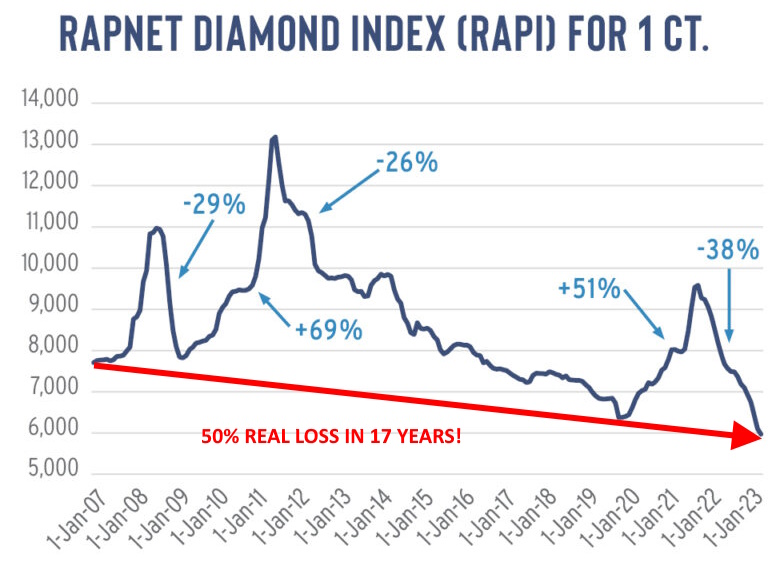Every week it seems there is more and more bad news being released about the diamond and jewellery industry. From diamond miners making a loss, to manufacturers making pseudo-layoffs to the falling sales and profits of jewellery retailers, the entire industry seems to be one in decline. Whilst every industry has its ups and downs, this downturn which started over two years ago, begs the question as to whether or not the entire industry is in permanent decline, and whether or not other factors, other than the overall decline in demand for natural diamonds point to the same conclusion?
Lab Grown Diamonds Have Savaged the Industry
Once upon a time, not too long ago (about five years ago to be exact), lab-grown diamonds were a mere novelty within the industry, seen not as a threat, but as an after-thought. With natural diamonds being the expensive product that they are, profits were albeit guaranteed, even though margins could, at times, be squeezed a little too tight for comfort.
Fast forward five years, and lab grown diamonds have seriously disrupted, if not destroyed the diamond industry. And it is not just natural diamond manufacturers and spruikers feeling the pain from this newfound competition – the lab grown diamond industry is suffering its own woes from rapidly declining prices. Diamond growers in the western countries, unable to compete with their Chinese and Indian counterparts seem to be dropping like flies. First it was US based diamond grower WD Lab Grown Diamonds filing for bankruptcy, and just last month, news broke that French based grower, Diam Concept has gone into receivership. However, things aren’t all rosy in India either, with workers of Surat based lab grown manufacturer Bhanderi violently protesting over unpaid wages. The dire situation in the lab grown industry has even prompted vice-president of the Diamond Workers Union Gujarat, Bhavesh Tank to state in the Financial Times that:
“Diamonds once sold at $500 per carat. Today nobody is ready to buy them at $40 per carat”

Above: Diamond price fluctuations aren’t anything new. Source.
However, whilst things are bad in the diamond industry now, I, amongst many in the industry are predicting a recovery, even if it a slow one in the latter part of 2024. The simple reason behind this thinking is that both mining and production will be cut to meet current level of demand, whereas demand will eventually increase, and the lab grown diamond market will shift away from fine jewellery to more fashion, and maybe designer jewellery.
Decline of Independent Jewellers
Independent jewellers are the heart of the industry. Whilst chain stores may dominate the industry nowadays, independent jewellers are who most people turn to when they need a repair, a custom designed piece or anything that isn’t “standard”. However, the number of independent jewellers has been declining for a number of years now. In their 2024 State of the Industry Report, Jeweller Magazine reports that between 2010 and 2023, the number of independent jewellery stores in Australia declined by 689 stores, or 26 percent to a total of 2010 stores. They did note that a re-classification of stores into different categories meant that between 100 and 150 businesses were not included in the 2023 numbers, meaning an actual decline of around 20 to 22 percent was recorded. Elsewhere in the world, things are even worse, with the number of jewellery retailers declining by 3.6% year over year.

Above: Australian jewellery store counts in 2023. Source.
Whilst Jeweller Magazine points out that retirements play a big part in the decline of independent jewellery stores, the changes that the industry has gone through over the past 20 years have seen the retail landscape change dramatically. As I wrote last year, both the internet and CAD/CAM have disrupted the industry, with these two changes alone no doubt adversely affecting the need for retail stores, something that Jeweller Magazine did allude to in their report. On the flip side, this has no doubt caused the number of bench jewellers and designers either working from home or from non-retail premises to increase.
Decline of Apprenticeships
In the past 20 years or so, jewellery apprenticeships have become as rare as hen’s teeth. In Perth, there are only a handful of traditional jewellery apprentices trained each year, which for a city of over two million people seems painfully low.
Recently, in the “Jobs for Jewellers” Facebook group, someone asked if there were any open apprentice positions, as is quite common in these types of groups. However, their question was met with an honest, but incredibly accurate response, essentially telling the would-be jeweller to seek an apprentice as an electrician and to learn jewellery on the side as you don’t need a trade qualification to be a jeweller, there is a wealth of knowledge available online and no one in the trade can afford to hire an apprentice anymore.
The lack of new jewellers entering the industry through apprenticeships, combined with the inevitable exodus of existing jewellers through retirement or simply moving out of the industry has created what some people are calling a bench jeweller shortage. However, I am always very skeptical when people in any industry say there is a “skills shortage”. More often than not, it is really a “money shortage”, with employers not willing to pay increased salaries for jobs that are in demand. Anecdotally, if I was to advertise for a bench jeweller 20 or more percent above market rates, I would get plenty of applicants. However, if I were to advertise the same position at market rates or below, I would likely not receive any applications.

Above: Is there really a bench jeweller shortage?
With CAD/CAM becoming increasingly popular throughout the industry, it is clear that the demand for bench jewellers has declined considerably. This, along with the rise of imported jewellery, is no doubt the primary cause of the decline in the numbers of jewellery apprentices. Whilst skillful bench jewellers and gemstone setters will always be needed, the skills needed to design and manufacture a piece of fine jewellery using modern techniques have shifted from the bench to the computer, with bench jewellers and setters now taking a back seat in the whole process. Therefore, with fewer bench jewellers available, employers are now finding that when they do need an experienced and/or skillful bench jeweller or setter, they need to be a lot more competitive in terms of salaries and benefits, leading to the inevitable cries of a “skills shortage”.
Final Thoughts
On the face of it, it certainly seems like the diamond and jewellery is in decline. However, like almost every industry, the root cause seems to be advances in technology – whether it be in growing diamonds, marketing jewellery or making jewellery. Unlike say newspapers or video stores however, it is highly unlikely that people will stop buying jewellery.